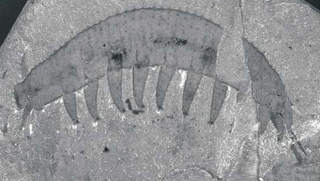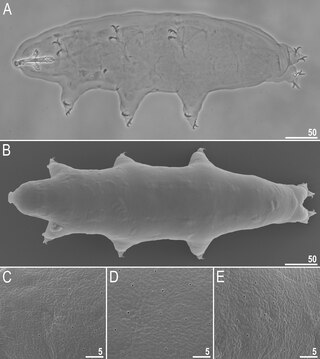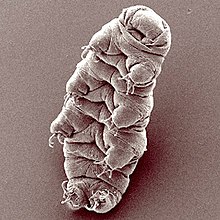
Heterotardigrades is a class of the tardigrades that have cephalic appendages and legs with four separate but similar digits or claws on each. 444 species have been described.

Aysheaia is an extinct genus of soft-bodied lobopodian, known from the Middle Cambrian Burgess Shale of British Columbia, Canada

Panarthropoda is a proposed animal clade containing the extant phyla Arthropoda, Tardigrada and Onychophora. Panarthropods also include extinct marine legged worms known as lobopodians ("Lobopodia"), a paraphyletic group where the last common ancestor and basal members (stem-group) of each extant panarthropod phylum are thought to have risen. However the term "Lobopodia" is sometimes expanded to include tardigrades and onychophorans as well.
Coelolepida is a clade of insects in the lepidopteran order, containing the infraorders Acanthoctesia, Lophocoronina, Neopseustina, Exoporia and Heteroneura, with the latter three grouped in clade Myoglossata.

Tardigrades, known colloquially as water bears or moss piglets, are a phylum of eight-legged segmented micro-animals. They were first described by the German zoologist Johann August Ephraim Goeze in 1773, who called them Kleiner Wasserbär'little water bear'. In 1776, the Italian biologist Lazzaro Spallanzani named them Tardigrada, which means 'slow walker'.

Hypsibius dujardini sensu lato is a species complex of tardigrade in the class Eutardigrada. A member of this complex, Hypsibius exemplaris, is widely used for various research projects pertaining to evolutionary biology and astrobiology. The species was described by Louis Michel François Doyère in 1840.

Echiniscus testudo is a cosmopolitan species of tardigrade.

Parachela is an order of tardigrades in the class Eutardigrada. Members of this order have existed for at least 72 million years, up to the present. The oldest known species are Beorn leggi and Aerobius dactylus.

Milnesium is a genus of tardigrades. It is rather common, being found in a wide variety of habitats across the world. It has a fossil record extending back to the Cretaceous, the oldest species found so far is known from Turonian stage deposits on the east coast of the United States. Milnesiums are one of the most desiccation and radiation-resistant invertebrates on Earth because of their unique ability to transform into a "tun" state and utilize intrinsically disordered proteins when experiencing extreme environments.

Tactopoda or Arthropodoidea is a proposed clade of ecdysozoan animals that includes the phyla Tardigrada and Euarthropoda, supported by various morphological observations. The cladogram below shows the relationships implied by this hypothesis.
Milnesium antarcticum is a species of Eutardigrades in the family Milnesiidae. This species differs from its cogenerate species mainly by proportions of its claws and buccopharyngeal apparatus.
Milnesium reductum is a species of Eutardigrades discovered by zoologist Denis. V. Tumanov in 2006. This species of Tardigrade is part of the family Milnesiidae. This species differs from its cogenerate species mainly by proportions of its claws and buccopharyngeal apparatus.

Beorn is an extinct genus of tardigrade and the first known fossil tardigrade, discocered in Late Cretaceous amber from Manitoba, Canada. The genus contains a single species, B. leggi, and it was originally classified as the only member of its family, the Beornidae, but was later reclassified as belonging to the Hypsibiidae.
Dsup is a DNA-associating protein, unique to the tardigrade, that suppresses the occurrence of DNA breaks by radiation. When human HEK293 cells were engineered with Dsup proteins, they showed approximately 40% more tolerance against X-ray radiation.

Macrobiotus shonaicus is a species of tardigrade in the family Macrobiotidae. As of 2018 it is only known from its type locality: Tsuruoka, Japan. The species description was published in 2018. The insides of their first three pairs of legs have a slight fold above their claws, and their eggs have processes whose terminal discs split off into thin filaments.
Bertolanius is a genus of tardigrades belonging to the family Eohypsibiidae.

Milnesium alpigenum is a species of tardigrade that falls under the Tardigrada phylum. Like its taxonomic relatives it is an omnivorous predator that feeds on other small organisms, such as algae, rotifers, and nematodes. M. alpigenum was discovered by Christian Gottfried Ehrenberg in 1853. It is very closely related to Milnesium tardigradum along with many other species from the Milnesium genus.
Milnesium lagniappe is a species of Eutardigrade in the family Milnesiidae. It is found in the southeastern United States, where it grows on lichens and plant litter. This microscopic creature belongs to the Milnesium granulatum species complex and is characterised by its claw formula, distinct cuticle features and stout claws with well-developed accessory points.

From the early 19th century, tardigrades' environmental tolerance has been a noted feature of the group. The animals are able to survive extremes of temperature, desiccation, impact, radiation, and exposure to the vacuum of space.











